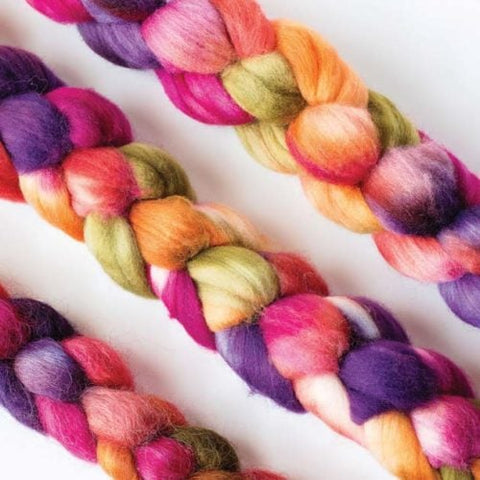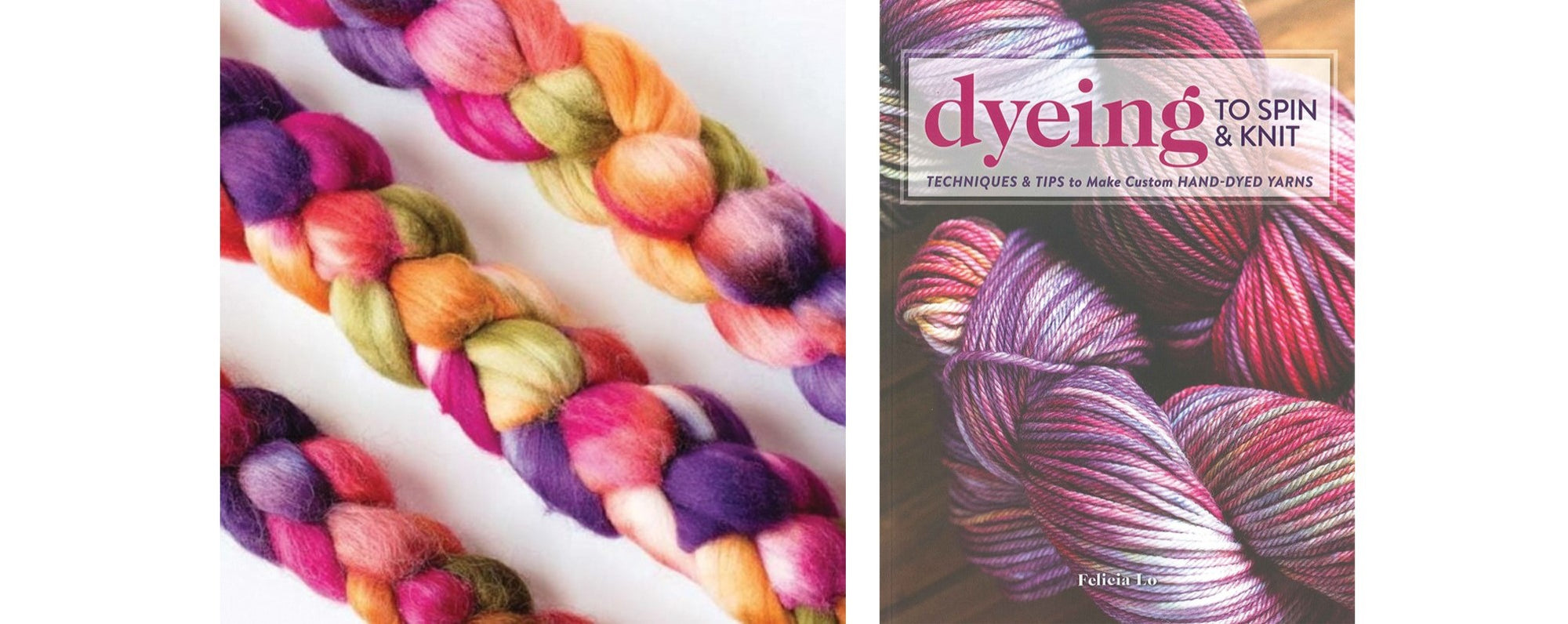Many thanks to Interweave for sharing this sneak peek from Felicia Lo's new book, Dyeing to Spin and Knit. We're thrilled to share this discussion of how staple length affects color. Be sure to read all the way to the end for an interview with Felicia as well!
How Staple Length Affects Color
A factor that affects the appearance of the final color in your yarn is the staple length of the fiber relative to the length of the dyed color sections. Colors are sharper, crisper, and cleaner when the length of the dyed color section is longer than the staple length of the fiber.

From bottom left to top right: Wensleydale, superwash merino, and merino fiber dyed with the same “Bouquet” colorway. There is a great deal of variation in how the different fibers take up the dye color.
For example, if we compare merino (with a typical staple length of 3 to 5 inches [7.5 to 12.5 cm)] with Wensleydale (staple length of 8 to 12 inches [20.5 to 30.5 cm)], both dyed with a colorway that has 6-inch(15 cm) color sections, the merino fiber should produce cleaner color changes than the yarn spun from the Wensleydale. At any given point along the fiber, the Wensleydale will have two different colors that cannot be separated cleanly because they are dyed on the same staple of fiber.

Staple lengths of different wool fibers. From left to right: Wensleydale, superwash merino, Polwarth+silk blend dyed in the “Bouquet” colorway. Longer staples in which more than one color has been dyed will produce a more blended and subdued spun yarn because the colors cannot easily be kept distinct.

Read our exclusive interview with author and dyer, Felicia Lo!
SCHACHT: We’ve admired your stunning sense of color over the years with your yarn dyeing at your company SweetGeorgia. What made you want to write this book?
FELICIA LO: For years now, I’ve been saying that SweetGeorgia is about passionate, relentless, and unapologetic color. It's about how color can inspire joy, give comfort, and provide healing for those working with it. And it’s become my personal mission to help people transform themselves, their crafts, and their lives through color. But over the years I found that people really want to enjoy color but they are still hesitant to try because they are worried about making the wrong color choices. My hope, with the book, is that people will gain the knowledge, skills, and confidence to create their own handcrafted color and be inspired to play with color through their knitting or spinning. I really want to take that fear and trepidation away, and replace it with confidence and joy.
SCHACHT: There’s so much to learn about color, what works and what doesn’t work. How have you developed your color sense over the years?
FELICIA LO: Absolutely, there is so much to learn and I’m still constantly learning new ways of working with color. Friends often say it must be genetic since my father is also a painter and printmaker with his own fine art career. But I think also much of my color sense was developed through a combination of art classes at design school where I studied in my 20’s as well as absorbing it through observing my father work on his paintings. I also worked as a graphic designer for much of my 20’s and early 30’s and my favorite part of the process was developing color palettes for client projects.
SCHACHT: We have found that there is a lot of fear about color. What is the best way for knitters and spinners to get comfortable with color?
FELICIA LO: No doubt, people are drawn to the same colors over and over and often worried about trying new colors… it’s probably the reason why my closet is 80% full of clothes that are some shade of purple, plum, fuchsia, navy, or gray. I have my personal favorite colors too and sometimes it's hard to break out into new color territory. One thing that might help with getting people comfortable with color, is use it in small quantities to start. Rather than knit a full cardigan out of hot pink, perhaps take that hot pink that you love and use it as a small design element or trim to a cardigan that is mostly in a neutral color. Using a “scary” color in a small dose might be just the trick. Another way to explore more color is to start creating color combinations together with your tried-and-true favorite colors and introducing a few new colors to your palette. And of course, the more you do it, the more comfortable you’ll be with it.

SCHACHT: Even though your book focuses on dyeing for spinning and knitting, it seems that much of what you include in your book could also apply to weavers. Do you have some suggestions on the best way for weavers to use your book?
FELICIA LO: There are so many wonderful ways to use hand-dyed yarns and color in weaving! It’s a realm I’m exploring now and enjoying so much. For weavers, I would look at the information on knitting with hand-dyed yarns because so much of it can be applied to weaving as well. The concept of mixing up colors in a variegated yarn by using multiple ends could be applied by holding multiple ends of either the same or different colored variegated yarns together while winding a warp. This technique could produce a beautifully mixed-up blend of different hues in your warp, where you can augment an existing skein of yarn with a similar color, or transform it entirely by mixing it with a yarn of a complementary color. The concept of “planned pooling” in knitting can also be applied to weaving in order to produce “faux handpainted warps” where the colors in a variegated yarn stack on top of each other to produce solid blocks of color. There are so many possibilities to try!
SCHACHT: You have a successful yarn business and now that Dyeing to Spin and Knit is published, how do you see your focus evolving?
FELICIA LO: For the past 12 years now, my focus has been very much about building and scaling an artisan handcrafted color business and producing beautiful color, fine quality knitting yarn, and spinning fiber. I feel so strongly that color is so essential to craft and creativity that I’m now focused on more ways to spread this joy of color with others through education and media. It’s so important that we maintain this community and craft of the fiber arts, make it contemporary and relevant, and preserve and update our skills and techniques in creating color, creating yarn, and creating fabric. So much of my focus now is on developing ways of sharing and teaching these skills in dyeing, knitting, spinning, and weaving so that more people can experience color and craft.

